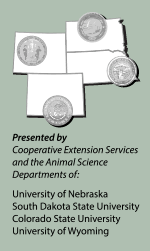Crossbreeding Strategies
LOVELAND, Colo. (Nov. 18, 2015) — Bob Weaber fears some cattlemen may let a quest for premiums cloud their focus on profitability. The Kansas State University geneticist believes the objective of any cow-calf operation should be to establish a system that matches its cows to the production environment while producing calves well-suited to the marketplace. Weaber thinks commercial cow-calf producers ought to consider how heterosis may help achieve that twofold objective and enhance profitability.

Bob Weaber
Speaking at the 24th Range Beef Cow Symposium hosted Nov. 17-19 in Loveland, Colo., Weaber acknowledged how genetic selection has altered beef cattle breeds, and how it shows in the dramatic changes to expected progeny difference (EPD) breed averages. He acknowledged the appeal of premiums paid for high-quality beef carcasses, admitting that capturing premiums can be profitable. Weaber reminded the audience, however, that the value added to a breeding herd by heterosis may be greater.
According to Weaber, crossbreeding offers two distinct and important advantages over the use a single breed. First, crossbred animals have heterosis, or hybrid vigor, which is a little boost to performance. Second, crossbred animals combine the strengths of the parent breeds. “Breed complementarity” is the term used to describe breed combinations that produce progeny exhibiting desirability across a broad range of traits.
“Using across-breed EPDs and adjustment factors, we can effectively select for improvement in a wide range of traits, including carcass traits, while seeking to build environmentally adapted cows that leverage the power and value of heterosis,” said Weaber.
Calling attention to the inverse relationship between heritability and heterosis, Weaber said low-heritability traits such as reproduction and cow longevity respond very slowly to selection, but improve significantly as a result of heterosis.
Noting the difficulty producers experience when trying to buy bulls that are suitable for siring terminal calves as well as replacement females, Weaber said a potential solution is to select different sires in accordance with two distinct breeding decisions.
“I suggest that producers consider making separate maternal and terminal mating decisions,” offered Weaber. “Use terminal-trait EPDs or selection indices to select bulls to sire calves with optimum terminal traits, and place maternal emphasis on selection of bulls to sire calves from which replacement females are chosen.”
Citing the pork and poultry industries’ use of different types of boars and roosters for terminal-trait-focused matings vs. maternal-trait-focused matings, Weaber said commercial cow-calf producers could use the same strategy to breed for optimal combinations of maternal traits, and separately breed for optimal combinations of terminal traits. “I think it’s overdue in our industry,” he added.
Weaber said each producer’s marketing practices and whether replacement females are raised or purchased will influence selection of a crossbreeding system. He advised adoption of a system that fits a producer’s unique operation and goals, and is as simple as possible to implement. He said a well-constructed crossbreeding system can have positive effects on the ranch’s bottom line, not only by increasing the quality and pay weight of calves sold, but also by increasing the durability and productivity of the cow factory.
“The objective,” emphasized Weaber, “should be to optimize everything except profit. Profit is what we want to maximize.”
Editor’s Note: This summary was written under contract or by staff of the Angus Journal®, which retains the copyright. To request to reprint this article, contact Shauna Rose Hermel, editor, at 816-383-5270. PowerPoints are posted with permission of the presenter and may not be reproduced in whole or in part without the express permission of the presenter. Angus Journal claims copyright to this web site as presented. We welcome educational venues and cattlemen to link to this site as a service to their audience.
The Angus Journal's coverage of the event is made possible through collaboration with the event committee and sponsorship of LiveAuctions.tv. For questions about this site, or to notify us of broken links, click here. Look for additional coverage in the Angus Journal, the Angus Beef Bulletin, the Angus Journal Daily, the Angus Beef Bulletin EXTRA and Angus TV.


